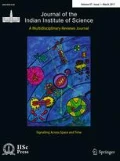Abstract
Our eyes are in constant motion, therefore, so we cannot solely use retinal information to determine the location of objects in space. Our ability to maintain a stable representation of the world despite a constantly moving eye is a phenomenon that has yet to be fully explained. However, two different mechanisms have been proposed as possible solutions. First, a corollary discharge of the eyes’ motor command as the eyes move about, was proposed by Herman von Helmholtz. On the other hand, a spatial representation via proprioceptive signals from nerve endings of eye muscles was proposed by Sir Charles Sherrington. We hypothesize that both mechanisms are used by the brain to achieve spatial accuracy and we present experimental results that support both ideas. While corollary discharge remaps the spatial representation even before an impeding saccade, oculomotor proprioception establishes an accurate spatial representation well after the saccade.







Similar content being viewed by others
References
Kupfermann I (1991) Localization of higher cognitive and affective functions: the association cortices. In: Kandel ER, Schwartz JH, Jessell TM (eds) Principles of neural science, 3rd edn. Elsevier, New York, NY, pp 823–838
von Helmholtz H (1928) Handbook of physiological optics, 3rd edn, translated by Southall JPC, Optical Society of America: New York, pp 242–281
Rose D (1999) The historical roots of the theories of local signs and labelled lines. Perception 28(6):675–685
Sherrington CS (1918) Observations on the sensual role of the proprioceptive nerve-supply of the extrinsic ocular muscles. Brain 41(3–4):332–343
Skavenski AA (1972) Inflow as a source of extraretinal eye position information. Vision Res 12(2):221–229
Hallett PE, Lightstone AD (1976) Saccadic eye movements to flashed targets. Vis Res 16:107–114
Andersen RA, Essick GK, Siegel RM (1985) Encoding of spatial location by posterior parietal neurons. Science 230(4724):456–458
Bruce CJ, Goldberg ME (1985) Primate frontal eye fields: I. Single neurons discharging before saccades. J Neurophysiol 53:603–635
Duhamel J-R et al (1992) Saccadic dysmetria in a patient with a right frontoparietal lesion: the importance of corollary discharge for accurate spatial behavior. Brain 115:1387–1402
Umeno MM, Goldberg ME (2001) Spatial processing in the monkey frontal eye field. II. Memory responses. J Neurophysiol 86:2344–2352
Walker MF, Fitzgibbon EJ, Goldberg ME (1995) Neurons in the monkey superior colliculus predict the visual result of impending saccadic eye movements. J Neurophysiol 73(5):1988–2003
Andersen RA, Mountcastle VB (1983) The influence of the angle of gaze upon the excitability of the light-sensitive neurons of the posterior parietal cortex. J Neurosci 3:532–548
Nakamura K, Colby CL (2002) Updating of the visual representation in monkey striate and extrastriate cortex during saccades. Proc Natl Acad Sci USA 99(6):4026–4031
Wang X, Fung CA, Guan S, Wu S, Goldberg ME, Zhang M (2016) Perisaccadic receptive field expansion in the lateral intraparietal area. Neuron 90:400–409
Sommer MA, Wurtz RH (2002) A pathway in the primate brain for the internal monitoring of movements. Science 296:1480–1482
Wang X et al (2007) The proprioceptive representation of eye position in monkey primary somatosensory cortex. Nat Neurosci 10(5):640–646
Xu BY, Karachi C, Goldberg ME (2012) The postsaccadic unreliability of gain fields renders it unlikely that the motor system can use them to calculate target position in space. Neuron 76(6):1201–1209
Karn KS, Møller P, Hayhoe MM (1997) Reference frames in saccadic targeting. Exp Brain Res 115(2):267–282
Poletti M, Burr DC, Rucci M (2013) Optimal multimodal integration in spatial localization. J Neurosci 33(35):14259–14268
Zivotofsky AZ et al (1996) Saccades to remembered targets: the effects of smooth pursuit and illusory stimulus motion. J Neurophysiol 76(6):3617–3632
Zivotofsky AZ, Goldberg ME, Powell KD (2005) Rhesus monkeys behave as if they perceive the Duncker Illusion. J Cognit Neurosci 17(7):1011–1017
Author information
Authors and Affiliations
Corresponding author
Rights and permissions
About this article
Cite this article
Sanchez, V., Zhang, W., Sun, L.D. et al. Corollary Discharge and Oculomotor Proprioception: Two Mechanisms for Spatially Accurate Perception and Action. J Indian Inst Sci 97, 533–542 (2017). https://doi.org/10.1007/s41745-017-0050-4
Published:
Issue Date:
DOI: https://doi.org/10.1007/s41745-017-0050-4




